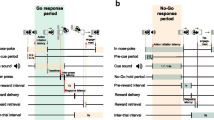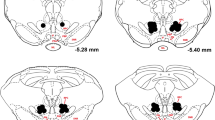Abstract
Rationale
There is evidence that serotonin2C (5-HT2C) receptors can modulate some behavioural effects of nicotine, but the generality of this action is not known.
Objective
To analyse the influence of the 5-HT2C agonist Ro-60-0175 on responses to nicotine in the five-choice serial reaction time task (5-CSRTT) and on its discriminative stimulus effect; these procedures constitute models for attention-enhancing and subjective effects of nicotine, respectively.
Materials and methods
In the 5-CSRTT, rats were trained to obtain food reinforcers by detecting light stimuli and then challenged with Ro-60-0175 (0.3–0.8 mg/kg) and nicotine (0.2 mg/kg). For drug discrimination studies, rats were trained to discriminate nicotine (0.2 mg/kg) from saline in a two-lever procedure using a tandem schedule of food reinforcement.
Results
In the 5-CSRTT, nicotine positively influenced most response indices, confirming previous results. Ro-60-0175 increased response latencies and omission errors and reduced anticipatory responding but had little effect on response accuracy; importantly, it counteracted the effects of nicotine on response speed and omission errors. Pentobarbitone (10–14 mg/kg) also slowed performance of the 5-CSRTT but did not weaken the nicotine-induced enhancement of performance. In the drug discrimination procedure, Ro-60-0175 was not generalised with nicotine but shifted the nicotine dose–response curve to the right in a dose-related manner.
Conclusions
The data suggest that selective occupancy of 5-HT2C receptors can attenuate some effects of nicotine in the 5-CSRTT and weaken the nicotine discriminative stimulus; these effects cannot be explained by a sedative action of Ro-60-0175.





Similar content being viewed by others
References
Ator NA, Griffiths RR (2003) Principles of drug abuse liability assessment in laboratory animals. Drug Alcohol Depend 70 (Suppl 1):S55–S72
Balfour DJK, Benwell MEM, Birrell CE, Keely RJ, Al-Aloul M (1998) Sensitization of the mesoaccumbens dopamine response to nicotine. Pharmacol Biochem Behav 59:1021–1030
Barnes NM, Sharp T (1999) A review of central 5-HT receptors and their function. Neuropharmacology 38:1083–1152
Batman AM, Munzar P, Beardsley PM (2005) Attenuation of nicotine’s discriminative stimulus effects in rats and its locomotor activity effects in mice by serotonergic 5-HT2A/2C receptor agonists. Psychopharmacology (Berl) 179:393–401
Baxter G, Kennett G, Blaney F, Blackburn T (1995) 5-HT2 receptor subtypes: a family re-united? Trends Pharmacol Sci 16:105–110
Benwell ME, Balfour DJK (1979) Effects of nicotine administration and its withdrawal on plasma corticosterone and brain 5-hydroxyindoles. Psychopharmacology (Berl) 63:7–11
Bizarro L, Stolerman IP (2003) Attentional effects of nicotine and amphetamine in rats at different levels of motivation. Psychopharmacology (Berl) 170:271–277
Dalley JW, Theobald DE, Eagle DM, Passetti F, Robbins TW (2002) Deficits in impulse control associated with tonically elevated serotonergic function in rat prefrontal cortex. Neuropsychopharmacology 26:716–728
De Deurwaerdere P, Navailles S, Berg KA, Clarke WP, Spampinato U (2004) Constitutive activity of the serotonin2C receptor inhibits in vivo dopamine release in the rat striatum and nucleus accumbens. J Neurosci 24:3235–3241
Desai RI, Barber DJ, Terry P (2003) Dopaminergic and cholinergic involvement in the discriminative stimulus effects of nicotine and cocaine in rats. Psychopharmacology (Berl) 167:335–343
Di Matteo V, Di Giovanni G, Di Mascio M, Esposito E (1998) Selective blockade of serotonin2C/2B receptors enhances dopamine release in the rat nucleus accumbens. Neuropharmacology 37:265–272
Di Matteo V, Pierucci M, Esposito E (2004) Selective stimulation of serotonin2c receptors blocks the enhancement of striatal and accumbal dopamine release induced by nicotine administration. J Neurochem 89:418–429
Eberle-Wang K, Mikeladze Z, Uryu K, Chesselet MF (1997) Pattern of expression of the serotonin2C receptor messenger RNA in the basal ganglia of adult rats. J Comp Neurol 384:233–247
Fletcher PJ, Chintoh AF, Sinyard J, Higgins GA (2004) Injection of the 5-HT2C receptor agonist Ro60-0175 into the ventral tegmental area reduces cocaine-induced locomotor activity and cocaine self-administration. Neuropsychopharmacology 29:308–318
Gasior M, Shoaib M, Yasar S, Jaszyna M, Goldberg SR (1999) Acquisition of nicotine discrimination and discriminative stimulus effects of nicotine in rats chronically exposed to caffeine. J Pharmacol Exp Ther 288:1053–1073
Gioanni Y, Rougeot C, Clarke PB, Lepouse C, Thierry AM, Vidal C (1999) Nicotinic receptors in the rat prefrontal cortex: increase in glutamate release and facilitation of mediodorsal thalamo-cortical transmission. Eur J Neurosci 11:18–30
Granon S, Passetti F, Thomas KL, Dalley JW, Everitt BJ, Robbins TW (2000) Enhanced and impaired attentional performance after infusion of D1 dopaminergic receptor agents into rat prefrontal cortex. J Neurosci 20:1208–1215
Grottick AJ, Fletcher PJ, Higgins GA (2000) Studies to investigate the role of 5-HT(2C) receptors on cocaine- and food-maintained behavior. J Pharmacol Exp Ther 295:1183–1191
Grottick AJ, Corrigall WA, Higgins GA (2001) Activation of 5-HT(2C) receptors reduces the locomotor and rewarding effects of nicotine. Psychopharmacology (Berl) 157:292–298
Hahn B, Stolerman IP (2002) Nicotine-induced attentional enhancement in rats: effects of chronic exposure to nicotine. Neuropsychopharmacology 27:712–722
Hahn B, Shoaib M, Stolerman IP (2002a) Nicotine-induced enhancement of attention in the five-choice serial reaction time task: the influence of task-demands. Psychopharmacology (Berl) 162:129–137
Hahn B, Shoaib M, Stolerman IP (2002b) Effects of dopamine receptor antagonists on nicotine-induced attentional enhancement. Behav Pharmacol 13:621–632
Hahn B, Shoaib M, Stolerman IP (2003) Involvement of the prefrontal cortex but not the dorsal hippocampus in the attention-enhancing effects of nicotine in rats. Psychopharmacology (Berl) 168:271–279
Harrison AA, Everitt BJ, Robbins TW (1997) Central 5-HT depletion enhances impulsive responding without affecting the accuracy of attentional performance: interactions with dopaminergic mechanisms. Psychopharmacology (Berl) 133:329–342
Higgins GA, Enderlin M, Haman M, Fletcher PJ (2003) The 5-HT2A receptor antagonist M100,907 attenuates motor and ’impulsive-type’ behaviours produced by NMDA receptor antagonism. Psychopharmacology (Berl) 170:309–319
Koelega HS (1993) Stimulant drugs and vigilance performance: a review. Psychopharmacology (Berl) 111:1–16
Lemmonds CA, Wenger GR (2003) Effects of drugs of abuse and signal predictability in two models of sustained attention in pigeons. Behav Pharmacol 14:279–294
Levin ED, Simon BB (1998) Nicotinic acetylcholine involvement in cognitive function in animals. Psychopharmacology (Berl) 138:217–230
Louis M, Clarke PBS (1998) Effects of ventral tegmental 6-hydroxydopamine lesions on the locomotor stimulant action of nicotine in rats. Neuropharmacology 37:1503–1518
Mansbach RS, Rovetti CC, Freedland CS (1998) The role of monoamine neurotransmitter systems in the nicotine discriminative stimulus. Drug Alcohol Depend 52:125–134
Mansvelder HD, van Aerde KI, Couey JJ, Brussaard AB (2006) Nicotinic modulation of neuronal networks: from receptors to cognition. Psychopharmacology (Berl) 184:292–305
Millan MJ, Girardon S, Bervoets K (1997) 8-OH-DPAT-induced spontaneous tail-flicks in the rat are facilitated by the selective serotonin (5-HT)2C agonist, RO 60-0175: blockade of its actions by the novel 5-HT2C receptor antagonist SB 206,553. Neuropharmacology 36:743–745
Mirza NR, Stolerman IP (1998) Nicotine enhances sustained attention in the rat under specific task conditions. Psychopharmacology (Berl) 138:266–274
Miyata H, Ando K, Yanagita T (2002) Brain regions mediating the discriminative stimulus effects of nicotine in rats. Ann N Y Acad Sci 965:354–363
Navailles S, De Deurwaerdere P, Porras G, Spampinato U (2004) In vivo evidence that 5-HT2C receptor antagonist but not agonist modulates cocaine-induced dopamine outflow in the rat nucleus accumbens and striatum. Neuropsychopharmacology 29:319–326
Picciotto MR, Corrigall WA (2002) Neuronal systems underlying behaviors related to nicotine addiction: neural circuits and molecular genetics. J Neurosci 22:3338–3341
Pidoplichko VI, DeBiasi M, Williams JT, Dani JA (1997) Nicotine activates and desensitizes midbrain dopamine neurons. Nature 390:401–404
Pierucci M, Di Matteo V, Esposito E (2004) Stimulation of serotonin2C receptors blocks the hyperactivation of midbrain dopamine neurons induced by nicotine administration. J Pharmacol Exp Ther 309:109–118
Pompeiano M, Palacios JM, Mengod G (1994) Distribution of the serotonin 5-HT2 receptor family mRNAs: comparison between 5-HT2A and 5-HT2C receptors. Brain Res Mol Brain Res 23:163–178
Porter RH, Benwell KR, Lamb H, Malcolm CS, Allen NH, Revell DF, Adams DR, Sheardown MJ (1999) Functional characterization of agonists at recombinant human 5-HT2A, 5-HT2B and 5-HT2C receptors in CHO-K1 cells. Br J Pharmacol 128:13–20
Pratt JA, Stolerman IP, Garcha HS, Giardini V, Feyerabend C (1983) Discriminative stimulus properties of nicotine: further evidence for mediation at a cholinergic receptor. Psychopharmacology (Berl) 81:54–60
Puttfarcken PS, Jacobs I, Faltynek CR (2000) Characterization of nicotinic acetylcholine receptor-mediated [(3)H]-dopamine release from rat cortex and striatum. Neuropharmacology 39:2673–2680
Quarta D, Ciruela F, Patkar K, Borycz J, Solinas M, Lluis C, Franco R, Wise RA, Goldberg SR, Hope BT, Woods AS, Ferre S (2007) Heteromeric nicotinic acetylcholine-dopamine autoreceptor complexes modulate striatal dopamine release. Neuropsychopharmacology 32:35–42
Rezvani AH, Caldwell DP, Levin ED (2005) Nicotinic-serotonergic drug interactions and attentional performance in rats. Psychopharmacology (Berl) 179:521–528
Ribeiro EB, Bettiker RL, Bogdanov M, Wurtman RJ (1993). Effects of systemic nicotine on serotonin release in rat brain. Brain Res 621:311–318
Robbins TW (1999) Arousal and attention: psychopharmacological and neuropsychological studies in experimental animals. In: Parasuraman R (ed) The attentive brain. MIT Press, Cambridge, MA, pp. 189–220
Robbins TW (2002) The 5-choice serial reaction time task: behavioural pharmacology and functional neurochemistry. Psychopharmacology (Berl) 163:362–380
Rodriguez R (1992) Effect of various psychotropic drugs on the performance of avoidance and escape behaviors in rats. Pharmacol Biochem Behav 43:1155–1159
Role LW, Berg DK (1996) Nicotinic receptors in the development and modulation of CNS synapses. Neuron 16:1077–1085
Schechter MD, Meehan SM (1992) Further evidence for the mechanisms that may mediate nicotine discrimination. Pharmacol Biochem Behav 41:807–812
Schechter MD, Rosecrans JA (1972) Nicotine as a discriminative cue in rats depleted of norepinephrine or 5-hydroxytryptamine. Psychopharmacologia 24:417–429
Schwartz RD, Lehmann J, Kellar KJ (1984) Presynaptic nicotinic cholinergic receptors labeled by [3H]acetylcholine on catecholamine and serotonin axons in brain. J Neurochem 42:1495–1498
Shannon HE, Love PL (2005) Effects of antiepileptic drugs on attention as assessed by a five-choice serial reaction time task in rats. Epilepsy Behav 7:620–628
Shearman E, Rossi S, Sershen H, Hashim A, Lajtha A (2005) Locally administered low nicotine-induced neurotransmitter changes in areas of cognitive function. Neurochem Res 30:1055–1066
Stolerman I (1992) Drugs of abuse: behavioural principles, methods and terms. Trends Pharmacol Sci 13:170–176
Stolerman IP, Garcha HS (1994) Failure of 5-HT3 antagonists and other drugs to block the nicotine discriminative stimulus. In: Harris LS (ed) Problems of drug dependence 1993. NIDA Research Monograph 141. U.S. Department of Health and Human Services, Rockville, MD, USA, p. 67
Stolerman IP, Mirza NR, Shoaib M (1995) Nicotine psychopharmacology: addiction, cognition and neuroadaptation. Med Res Rev 15:47–72
Stolerman IP, Pratt JA, Garcha HS, Giardini V, Kumar R (1983) Nicotine cue in rats analyzed with drugs acting on cholinergic and 5-hydroxytryptamine mechanisms. Neuropharmacology 22:1029–1037
Summers KL, Giacobini E (1995) Effects of local and repeated systemic administration of (-)nicotine on extracellular levels of acetylcholine, norepinephrine, dopamine, and serotonin in rat cortex. Neurochem Res 20:753–759
van Gaalen MM, Brueggeman RJ, Bronius PF, Schoffelmeer AN, Vanderschuren LJ (2006) Behavioral disinhibition requires dopamine receptor activation. Psychopharmacology (Berl) 187:73–85
Vizi ES, Lendvai B (1999) Modulatory role of presynaptic nicotinic receptors in synaptic and non-synaptic chemical communication in the central nervous system. Brain Res Brain Res Rev 30:219–235
Wenger GR, Wright DW (1990) Disruption of performance under a titrating matching-to-sample schedule of reinforcement by drugs of abuse. J Pharmacol Exp Ther 254:258–269
Winstanley CA, Theobald DE, Dalley JW, Glennon JC, Robbins TW (2004) 5-HT2A and 5-HT2C receptor antagonists have opposing effects on a measure of impulsivity: interactions with global 5-HT depletion. Psychopharmacology (Berl) 176:376–385
Wonnacott S, Irons J, Rapier C, Thorne B, Lunt GG (1989) Presynaptic modulation of transmitter release by nicotinic receptors. Prog Brain Res 79:157–163
Zoli M, Moretti M, Zanardi A, McIntosh JM, Clementi F, Gotti C (2002) Identification of the nicotinic receptor subtypes expressed on dopaminergic terminals in the rat striatum. J Neurosci 22:8785–8789
Acknowledgements
We gratefully thank the European Union and Medical Research Council for financial support and F. Hoffmann-La Roche, Basel, Switzerland for kindly donating Ro-60-0175. Ian Stolerman was a member of the External Scientific Staff of the Medical Research Council. Britta Hahn kindly provided insightful comments on an earlier version of this report. There are no relevant financial interests to disclose, or a conflict of interest of any kind. The experiments comply with the laws of the UK.
Author information
Authors and Affiliations
Corresponding author
Electronic supplementary material
Below is the link to the electronic supplementary material.
Rights and permissions
About this article
Cite this article
Quarta, D., Naylor, C.G. & Stolerman, I.P. The serotonin2C receptor agonist Ro-60-0175 attenuates effects of nicotine in the five-choice serial reaction time task and in drug discrimination. Psychopharmacology 193, 391–402 (2007). https://doi.org/10.1007/s00213-007-0802-3
Received:
Accepted:
Published:
Issue Date:
DOI: https://doi.org/10.1007/s00213-007-0802-3




